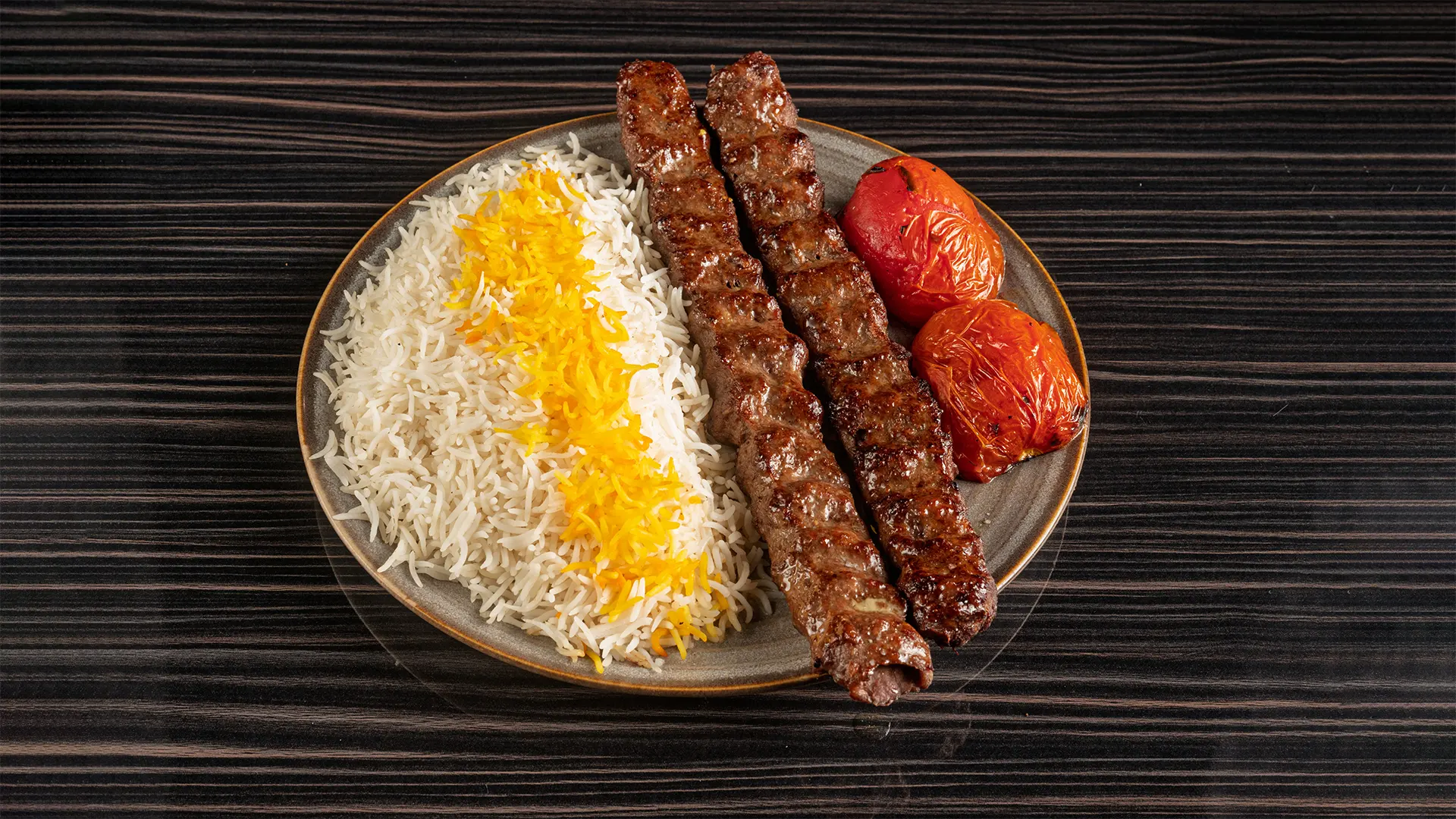Kabāb Koobideh-Beef (کباب کوبیده گوشت گاو)—more casually Beef Koobideh—is Iran’s iconic minced-meat kebab: ribbons of seasoned ground beef molded onto wide metal skewers and licked by charcoal flames until smoky, juicy, and lightly char-marked. Named for the verb koobidan (“to pound”), the recipe dates back to soldiers who mashed meat with flat stones on their shields before grilling over campfires; today it’s the backbone of every chelokabābi menu from Tehran to Mashhad.
Essence & Cultural Role
Unlike barg (whole-fillet kebab), koobideh celebrates economy and technique: fat-marbled beef gets emulsified with grated onion, salt, and a whisper of saffron until the mixture turns sticky enough to cling to skewers in slender ridges. The sizzle as melted fat drips on hot coals perfumes streets and backyards, drawing families to Friday picnics, Nowruz gatherings, or midnight curbside stands. A proper serving always includes snowy chelo rice, a grilled tomato, raw onion wedges, and a shower of sumac.
Core Ingredients (6 skewers / 4–5 servings)
| Ingredient | Metric | US |
|---|---|---|
| Ground beef, 20 % fat | 900 g | 2 lb |
| Large onion, grated & juice squeezed | 1 (200 g) | 1 cup pulp |
| Kosher salt | 2 tsp | 2 tsp |
| Freshly ground black pepper | 1 tsp | 1 tsp |
| Turmeric (optional, Tehran style) | ½ tsp | ½ tsp |
| Ground saffron steeped in 2 Tbsp hot water | pinch | pinch |
To serve: 6 cups steamed chelo rice, 4 Roma tomatoes, pats of butter, sumac, raw onion, fresh herbs (sabzi khordan).
Quick Preparation
-
**Emulsify **Spread beef on a tray. Sprinkle salt, pepper, turmeric, and onion pulp (juice discarded). Drizzle saffron water. With damp hands, knead 4–5 min until sticky strands form and the mix no longer cracks—critical for skewer grip.
-
**Chill **Cover tightly; refrigerate 1–2 h (or overnight) to firm.
-
**Skewer **Wet hands. Take a lemon-sized ball, press onto a flat 2 cm-wide metal skewer, then pinch and drag to a 20 cm (8 in) ribbon ~1 cm thick. Use two fingertips to create shallow ridges every 2 cm; they help fat render evenly.
-
**Grill **Set skewers over a bed of glowing charcoal, edges resting on the fire box so meat hovers just above coals. Turn every 30 s for the first 2 min to “set” the kebab; then cook 3–4 min per side until browned, beads of fat sizzling. Grill tomatoes alongside until blistered.
-
**Serve **Slide kebabs onto a platter. Dot rice with butter, spoon a line of saffron rice (tah-e-zafarān) on top, lay kebabs and tomatoes beside, and pass sumac for sprinkling.
Variations
-
Mixed Meat (Koobideh Loghmeh): Blend equal parts beef and lamb shoulder for deeper flavor.
-
Herbed Koobideh: Knead in 2 Tbsp minced parsley and chives—popular in Azerbaijan province.
-
Pan-Broiler Hack: Form logs on soaked wooden skewers, sear in a cast-iron grill pan, then finish under a broiler when outdoor grilling isn’t possible.
-
Stuffed Koobideh: Enclose a thin strip of mozzarella or barberries inside the meat before skewering for a modern twist.
Pairing Tips
Beef Koobideh shines with chilled mast-o-musir, crisp Salad-e Shirazi, fiery torshi bandari, and an ice-cold glass of doogh. If you enjoy wine, reach for a light, high-acid red (e.g., Beaujolais-style) that won’t overpower the saffron and smoke.
Nutritional Snapshot (per skewer with 1 cup rice)
≈ 610 calories • 33 g protein • 26 g fat (mostly monounsaturated) • 57 g carbs • rich in iron, zinc, and oleic acid from beef fat; antioxidants from saffron and tomatoes.
Smoky, succulent, and ready to mingle with buttered rice and tangy sumac, Beef Koobideh embodies Persian hospitality in each sizzling skewer—proof that a handful of everyday ingredients can create unforgettable flavor when technique and tradition meet glowing coals.
